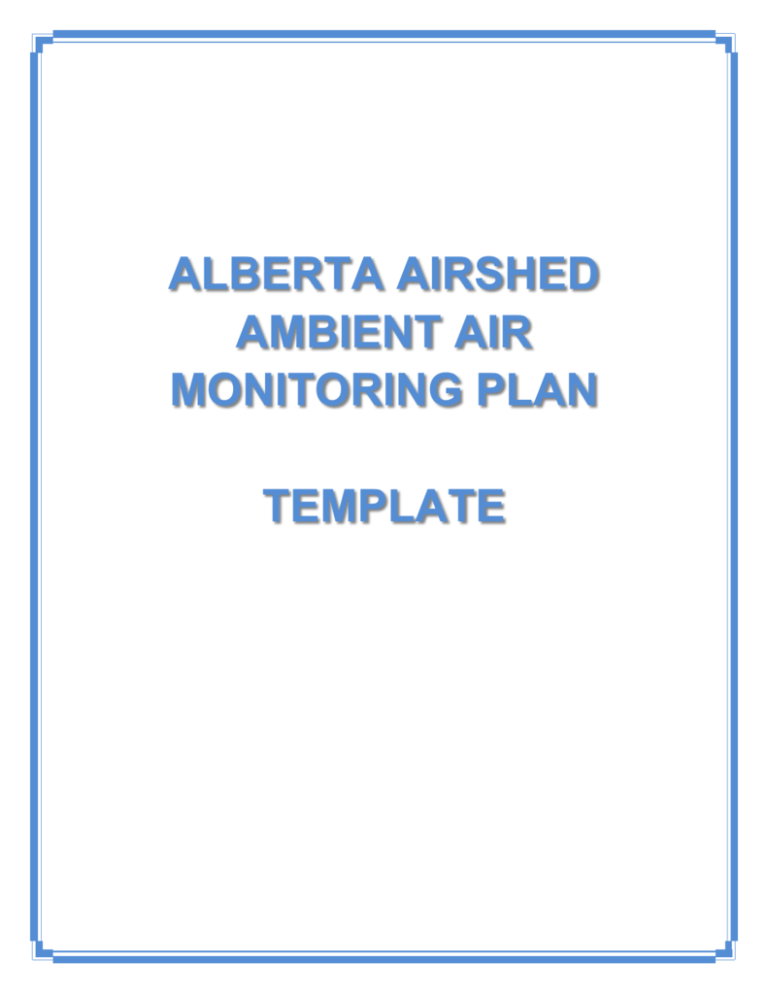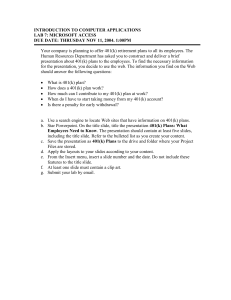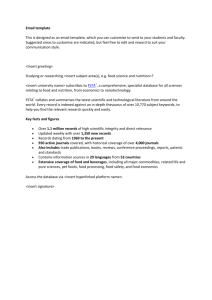Alberta Airshed Ambient Monitoring Plan template
advertisement

ALBERTA AIRSHED AMBIENT AIR MONITORING PLAN TEMPLATE Ambient Air Monitoring Plan Title of program (or portion covered by this plan) Prepared for: Enter contact information and address Prepared by: Enter contact information and address Date The submitter shall sign, date and submit the ambient air monitoring for approval. Once approved the Director will sign, date and return one of the submitted copies as authorization to proceed with implementation of the approved plan. Signature of Submitter Date Name and title of Submitter Authorization to Implement Plan Date Name and title of Authorizing Authority i TABLE OF CONTENTS Update TOC, List of Tables and Figures when Monitoring Plan is complete. TABLE OF CONTENTS .................................................................................................. ii LIST OF TABLES .......................................................................................................... iii LIST OF FIGURES......................................................................................................... iii INSTRUCTIONS ............................................................................................................. 1 1.0 GENERAL INFORMATION .................................................................................. 1 1.1 Description of Need(s) for Air Monitoring Program(s) ...........................................1 1.2 Responsible Authorities for Monitoring Plan ..........................................................1 1.3 Documentation of Monitoring Objective(s).............................................................2 2.0 MONITORING INFORMATION ............................................................................ 2 2.1 Monitoring Location(s) ............................................................................................2 2.2 Substance(s) to be Monitored ..................................................................................3 2.3 Method of Monitoring..............................................................................................4 2.3.1 Rationale for Monitoring Methods Used .....................................................4 2.4 Monitoring Schedule (if monitoring for less than 12 months per year) ..................5 3.0 EMISSIONS AND RECEPTORS.......................................................................... 5 3.1 Emission(s) Sources .................................................................................................5 3.2 List of Identified Receptors .....................................................................................5 4.0 DATA MANAGEMENT ........................................................................................ 6 4.1 Data Management ....................................................................................................6 5.0 IMPLEMENTATION ............................................................................................. 6 5.1 Implementation Timeline .........................................................................................6 6.0 CONTINGENCY PLANNING ............................................................................... 6 6.1 Contingency Plans / Risk Management for Ongoing Operations ............................6 ii LIST OF TABLES Table 1 Table 2 Table 3 Table 4 List of contributors to the monitoring plan ............................................................. 1 Contributions to monitoring program plan ............................................................. 2 List of monitoring locations .................................................................................... 2 Method of Monitoring............................................................................................. 4 Additional as required. LIST OF FIGURES As required. iii INSTRUCTIONS This ambient air monitoring plan template was prepared based on the Air Monitoring Directive “Chapter 2: Ambient Air Monitoring Program Planning”. This template contains an outline of the monitoring plan elements and a brief description of the information that should be included within each section (in purple text). The template can be used when submitting an ambient air monitoring program plan for an existing, new or revised monitoring program. This template is only guidance. Users of this template must consult “Chapter 2: Ambient Air Monitoring Program Planning” of the Air Monitoring Directive (AMD) for requirements, as the AMD takes precedence. 1.0 GENERAL INFORMATION 1.1 Description of the ambient air quality or related deposition issues(s) in the area Clearly describe the issues that monitoring will address in the area, including the drivers that do or may have an impact on environmental conditions, this will help identify the scope of the air monitoring program. <insert text> 1.2 Responsible Authorities for Monitoring Plan Complete the following table for contributors to development and implementation of the monitoring plan. Table 1 Name List of contributors to the monitoring plan Address Affiliation 1 Describe the contribution of each of the people listed in Table 1 to the monitoring plan or the implementation process. Table 2 Contributions to monitoring program plan Name 1.3 Contribution to Plan Documentation of Monitoring Objective(s) Clearly describe the objective(s) of the monitoring program. <insert text> 1.4 The geographical area for the monitoring program, including the ecosystem and/or population within that area Clearly describe the boundary of the monitoring program (latitude-longitude, municipal boundary etc.). <insert text> 2.0 MONITORING INFORMATION 2.1 Monitoring Location(s) Provide a map indicating monitoring locations, including land use (urban, industrial, rural) and locations of affected receptors, protected and/or sensitive ecosystems. Table 3 Site No./Name List of monitoring locations Longitude Latitude Land Use 2 Identify the number of monitoring installation site(s), what the monitoring duration is for each site, and rationale for number and location of sites. <insert text> Include appropriate meteorological analysis - Wind roses using a minimum five years of data from the nearest representative station - For areas with no representative meteorological station, prognostic data (e.g. MM5) may be used to conduct analysis <insert text> Note any limitation(s) on access to monitoring site(s) e.g., can the site be accessed in all seasons, are there any restrictions to vehicle or personnel access. <insert text> Identify any siting criteria deviation(s) from the AMD and provide rationale for the deviation. <insert text> Provide rationale for the relocation or discontinuation of any monitoring. <insert text> 2.2 Substance(s) to be Monitored Provide the following information: Rationale for selecting substance(s) Historical monitoring data on substance(s), if available Source of the historical monitoring data, if used Summary of modelling results if available <insert text> 3 2.3 Method of Monitoring Provide the following information for each monitoring method (can be listed by station). Table 4 Method of Monitoring Monitoring/Instrumentation Method 2.3.1 Detection Limit Full Scale Precision Accuracy Sampling Frequency Rationale for Monitoring Methods Used Provide the rationale for the choice of monitoring method(s). <insert text> 4 Sampling Duration 2.4 Monitoring Schedule (if monitoring for less than 12 months per year) Provide the start and end dates of the monitoring period (for each year, to a maximum of five years). Contingency plan if monitoring period requirements are not met. <insert text> 2.5 Duration of Monitoring Program Advise if the program is: - Continuous - Seasonal - Intermittent - Short- or long-term <insert text> 3.0 EMISSIONS AND RECEPTORS 3.1 Emission(s) Sources List of identified emission source(s) from industrial and non-industrial Location of source(s) Emissions inventory, if available Source of emission inventory, if used Transboundary issues, if any – does information indicate there is transport of substances from outside of the monitoring program area. <insert text> 3.2 List of Identified Receptors Describe which receptors are most sensitive to the emissions/deposition. Location of receptors on a map (Section 2.1) <insert text> 5 4.0 DATA MANAGEMENT 4.1 Data Management Include the following information: How long will the raw data be archived Where will the raw data be archived Quality System in place Method for additional data processing (if required) Party conducting QA/QC Method for managing the data versions Method for submission into centralized data warehouse <insert text> 5.0 IMPLEMENTATION 5.1 Implementation Timeline Include timelines for: Monitoring site selection and preparation Timeframe to secure operator Timeframe to acquire any new equipment Equipment installation and testing Data collection All other milestones and completion dates <insert text> 6.0 CONTINGENCY PLANNING 6.1 Contingency Plans or Risk Management for Ongoing Operations Provide a description of the contingency plans in place for disruption in operations including the following scenarios: Monitoring site security or theft Forest fire or wildlife intrusion Contract disruption Power failure, communication failure, etc. 6 <insert text> 7.0 MONITORING PLAN REVIEW 7.1 Date of last monitoring plan review <insert text> 7.2 Summary of findings from last monitoring plan review Any changes required to the plan required following the last review Any changes implemented since last review <insert text> 7






